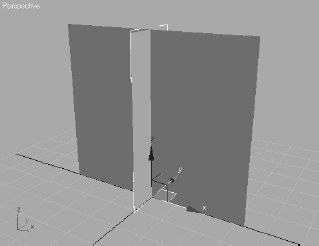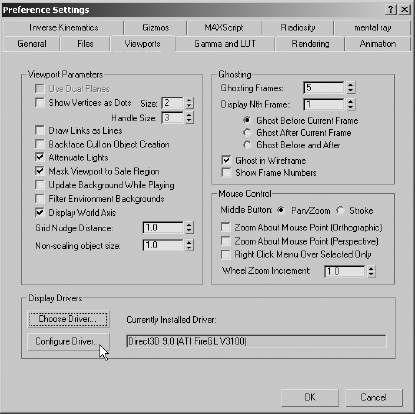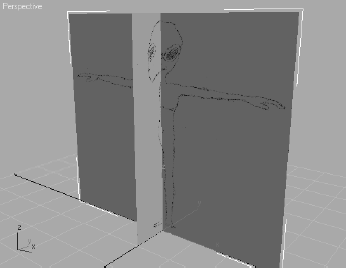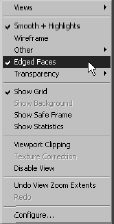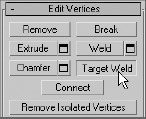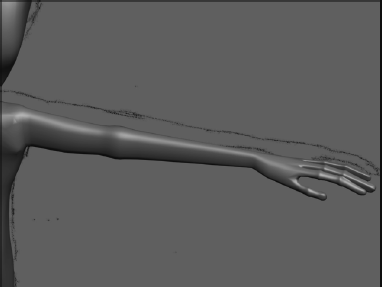Organic modeling is typically used when you create natural objects, such as a tree trunk, a hilly landscape, or a character. These models are generally of a higher polygon count than most, because organic models require smooth surfaces and need to be seamless. With a more mechanical model such as the dresser you modeled in Chapter 4, "Modeling in 3ds Max: Part I," there is little to no need for highly detailed, high-polygoncount surfaces. A human head model for a character, however, needs finely detailed surfaces because an organic model's parts need to flow together seamlessly. With the human head model, there should really be no clear distinction between where the geometry of the lower lip stops and the jaw starts, or where the top of the nose ends and the forehead begins. A basic knowledge of anatomy and an understanding of balance and proportion are important when you're designing a character that needs to be appealing and believable.
Realistic computer-generated (CG) characters are already very common in television and films; they appear as stunt doubles, as vast crowds of people, and even as primarycharacters to the scene or even the entire show. There are several situations where using aCG character works better for a show than using a real person. For example, CG stunt doubles are safer and sometimes cheaper than using an actual stunt person.
Another opportunity for organic character modeling arises when a storyline calls for anunusual or nonhuman character. Weird creatures can be created with better clarity using CG than using puppetry or special makeup effects. In any case, there is a large call for good character and organic modelers in both high and low poly counts.
This chapter introduces you to character modeling, focusing on using the editable poly toolset to create an organic alien model suitable for character animation. With the exceptionof the alien's eyes, the model will be a single object created from a very basic form. There are a few other tools, such as Surface tools, in 3ds Max that are also used in character modeling, but these are more advanced and beyond the scope of this introductory book. However, the concepts and practices talked about in this chapter will set you up with a solid foundation for any kind of character modeling.
Topics in this chapter include:
Setting Up the Scene
Creating the Basic Form
Adding Detail
Final Touches
As mentioned already throughout the previous chapters, acquiring and utilizing good reference material is essential for creating a successful character. At the minimum, sketchesof the character's front and side features are necessary. You can import and use these views as background images as you create the character in 3ds Max. Additional perspective sketchesof your intended character from several points of view and sketches of specific features, such as headgear, weapons, or other devices, can be very helpful during the modeling process for quick reference to your goal.
Creating Planes and Adding Materials
Like the toy rocket exercise in Chapter 5, "Modeling in 3ds Max: Part II," this exercise begins by creating crossed boxes and applying the reference images to them.
In a new scene, go to the Top viewport and create a tall, wide box oriented along the X-axis.
In the Parameters rollout of the Command panel, set the Length to a very small value, such as 0.05, Width to 66, and Height to 56. This essentially gives us a flat plane. Ifyour computer display displays the plane improperly, change the Length value to something slightly higher. The point here is to have as flat a plane as possible without messing up your display.
Note
When using certain displays, you may see artifacting with a very thin object such as this thin box you created in Steps 1 and 2. This is inherent in the display and not necessarily the geometry. Rendering the frame should show you if it's a display or an object problem.
Rename this box Alien Front Image.
With the box still selected, click the Move tool (


The box will move to the origin, as shown here.

Create another box in the Top viewport. This rectangle should be oriented along the Y-axis (i.e., the Top viewport's vertical axis). Go to the Modify panel and set the Length to 20, Width to 0.05, and Height to 56, and then rename the box object Alien Side Image.
Move this box to the origin as well. The Perspective viewport should look similar to Figure 6.1. You will use these crossing boxes to outline the shape of your alien model.
Note
You may be wondering why the boxes were created in the Top viewport instead of the Front and Side viewports, which is how they end up being oriented. When the box is created in the Top viewport, the pivot point (or Transform gizmo) is positioned at the bottom of the box sothe box is automatically aligned along the Home Grid, which saves you a step in the long run.
Adding the Materials
The reference materials are then texture mapped onto the crossing boxes to provide reference inside the scene itself while you model the character. Therefore, it's critical to ensure that the features of the character that appear in both reference images (the front and theside), are at the same height. For instance, the top of the head and the shoulders should be at the same height in both the front and side views to make the modeling process easier, eliminating as much guesswork as possible.
Click the Material Editor icon (

Select the top-left sample sphere by clicking in it, as shown here. This is the sample slot where you will make the material that will map the front view reference of the alien character. For more on texturing and mapping, see Chapter 7, "Materials and Mapping."

Expand the Maps rollout in the Material Editor, and click the Diffuse Colorbutton (currently labeled None), as shown here. This will open the Material Map browser.

Double-click the Bitmap entry at the top of the Material/Map browser, asshown here. This allows you to import an image file to place onto the material to be mapped onto the box.

In the Select Bitmap Image File dialog box that opens, navigate to the Chapter 6 files on the companion CD and select the
Alien Sketch Front.jpgfile. Click the Open button to add the front alien image to the material as shown.

In the Material Editor's horizontal toolbar, click the Show Map in Viewport button, as shown here. This will allow you to see the image map in all the viewports that are using the Smooth +Highlights display once the material has been assigned to the box.

With the Alien Front Image box selected in the scene (shown here), click the Assign Material to Selection button in the Material Editor toolbar. The alien's front reference image will now be displayed on the face of the box.
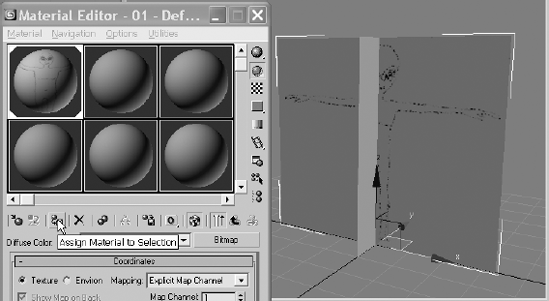
Note
Reference images do not work very well in 3ds Max when they are drawn on white paper before they are scanned to a digital file. By default, white is the color of selected objects in 3ds Max, so scene objects can be visually lost when they are in front of a reference image that is drawn on a white background. If the drawings are on white background, use Photoshop, oranother image-editing package, to process the images to make the background gray.
In the sample slot area of the Material Editor, select the sample slot to the right of the current slot, as shown here. Its boundary will turn white to indicate that it is thecurrent material.
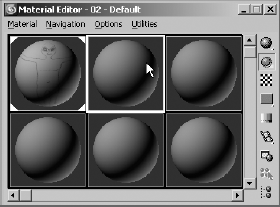
Repeat steps 2 through 5, this time choosing the
Alien Sketch Side.jpgfile in theSelect Bitmap Image File dialog box to import the side view of the alien.Select the narrower box and click the Assign Material to Selection button. Your Perspective viewport should look like Figure 6.2. If the images do not appear in the viewport, right-click the viewport's title and choose Smooth → Highlights from the pop-up menu to change the viewport rendering mode. Close the Material Editor.
The alien form we are modeling here is pretty common: one large head, one neck, two arms, a torso, and two legs. This is pretty standard for bipedal, humanoid 3D characters. You can always embellish this alien later on by adding facial features, for example, or modeling more detailed arms and legs.
When you create an organic character, you might be tempted to try to model one piece of the final product, such as the head or hands, to completion before you begin modeling another piece of the character. This is rarely a good idea because the scale andbalance of the components must be built together from the beginning. A better practiceis to block out the basic form of the character and focus on the size and crucial shapes of the major elements, and then add detail for the finer features. The following exercises describe the steps required to block out the alien's major features. When you feel you have gained enough confidence, we encourage you to step back into this alien exercise and redesign the alien with more intricate features, or even add an additional set of arms to the torso. Go wild!
Blocking the Torso
The basic structure for the torso will begin with a simple box primitive. After converting the box into an editable spline, you will add the Symmetry modifier to the object so that any manipulations performed on one side are instantly performed on the other. Is that cool or what?
Continue with the previous exercise's scene file, or open the Alien1.max scene file in theAlien Model folder on the companion CD.
Right-click on the name of each viewport that has Smooth + Highlights display enabled, and choose Edged Faces to display the rendered surfaces and the edges of each face.
In the Top viewport, create a box with Length, Width, and Height segments set to 2.
Rename the box Alien and change its display color, if necessary, to a color that contrasts well against the boxes that display the front and side reference images.
Move the box upward until it is centered on the torso in the reference images and modify its parameters to fit the torso. It's better if the box is slightly smaller than the sketched torso so that the image is visible beyond the box (similar to the box shownin Figure 6.3.)
Convert the box into an editable poly object.

Access the Vertex sub-object level, and delete the left half of the box by dragging a selection region around the left-most vertices as shown and then pressing the Delete key.

Switch to the Modify tab of the Command panel and apply the Symmetry modifier to the box. The Symmetry modifier allows you to model only one side of the character while 3ds Max models the reciprocal side automatically. You can see the left half of the box return, as shown here.

The box currently obscures the reference images and can make modeling more difficult. Turning on the See-Through mode in the object's properties will reduce this problem. With the Alien object selected, right-click in the viewport and choose Object Properties from the Quad menu, as shown here.

In the Object Properties dialog box—which should now be open—check the See- Through option in the Display Properties section shown here and then click the OK button. The object will become transparent in the viewports, and the edges will remain visible. Now, that's better.

Forming the Torso
You will begin forming the basic shape of the torso by moving the editable poly's vertices and extruding its polygons in the following steps.

In the Modify panel, select the editable poly level of the Modifier Stack, as shown here. The left side of the object will disappear, but don't worry; the left side will still be there when you return to the Symmetry modifier. This allows you to select vertices with a selection region in the Right viewport without selecting the vertices on the opposite side as well.
Access the Vertex sub-object level and start to form the torso by moving the vertices in the Front viewport to match the background image, as shown in Figure 6.4. Use a selection region to select both the front vertices and the vertices directly behind them.
Switch to the Right viewport and move the vertices to match the side-view reference image.

The alien's back has two curves; a concave curve at the lower part of the spine and a convex curve at his rear. The alien's front has a similar, more subtle compoundcurve. The editable poly object, however, does not have enough vertices to match the complexity of the image. We will use the Chamfer tool to refine or soften an edge by subdividing it into two colinear edges, with new polygons located between them. For more on the Chamfer tool, see Chapter 4. The angle between the new polys and the old polys is one-half the previous value. When the polys on both sides of the edges are coplanar, no new angle is introduced to the model, but a gap is created between two new edges.
In the Selection rollout, click the Edge button (

Select the four edges that go around the alien's belly horizontally like a belt. Switchviewports as necessary to select them all. You can also just select one of the edges, and use the Loop function to select the other edges that go all the way around the belly. For more on the Loop function, see Chapter 4.
In the Edit Edges rollout, click the Chamfer button, as shown here.
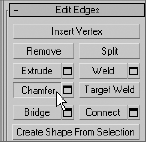
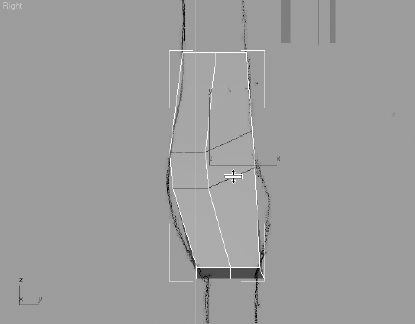
Click and drag on any of the selected edges to chamfer all of them, creating a new loop of edges around his belly as shown.
Release the mouse button. Click and drag again to add two more rings of edges and further refine the mesh. Make sure that you do not drag so far that the new edges overlap.
Switch back to the Vertex sub-object level and continue to move the vertices to match both the front and side reference images, as pictured here.

Switch to the Perspective viewport. Zoom and arc-rotate the view to see the top polygon in the model.
In the Polygon sub-object level, select the top polygons in the model and click on theExtrude tool in the Edit Polygons rollout. Be sure to select both the front polygon andthe rear polygon hidden behind the flat box with the front reference image.
Click and drag the top polygons to extrude them approximately one-third the distance to the alien's armpit. Release the mouse button and repeat the process two more times until the top polygon is even with the top of the alien's armpit.
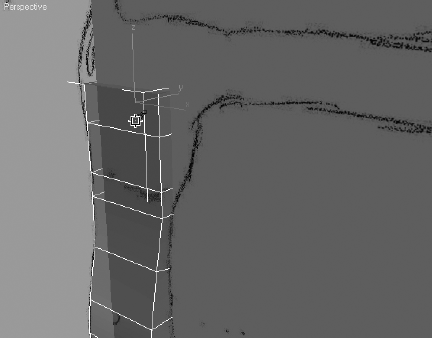
Switch back to the Vertex sub-object level and move the new vertices to match the reference images. The inner pair of vertices should be higher than the other pair, causing the top edges to no longer be parallel to the others, as shown here.

Cleaning Up the Geometry
When you create models with the editable poly toolset, you will often generate unnecessary or unwanted polygons. In this section, you will eliminate some internal polygons that the model doesn't need.
Continue from the previous exercise. Select all of the polygons in the model, rightclick in the viewport for the Quad menu, and choose Isolate Selection. The two boxes will disappear, and the torso will remain.
Arc-rotate the viewport to look at the inner surfaces between the two halves of the model. You will be able to see the six internal polygons created with the Extrudetool, as shown in Figure 6.5. You might need to turn off the See-Through mode to see these polygons clearly, though. These, and the six additional polygons created by the Symmetry modifier, are undesirable because they make the model unnecessarily complex and can affect later results when you use several of the Polygon Editing tools. It's important to stay on top of any extra polys you create to keep your model efficient.
Select and delete the six internal polygons by pressing the Delete key.
In Edge sub-object mode, select all the edges, front and back, from the alien's shoulder to its hip and then chamfer these edges, as shown here. The new polygons created by the Chamfer tool will form the curvature around the sides of the alien.

Exit the Edge sub-object level. Click the Symmetry entry in the Modifier Stack to see the full model of the torso so far. Both sides will display, as shown here.
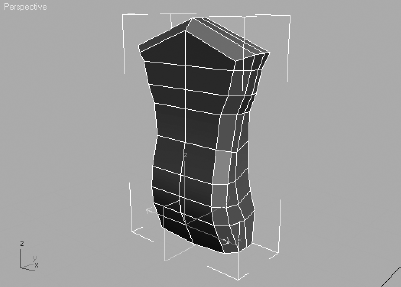
Exit Isolation mode by clicking the floating yellow Exit Isolation Mode button. Save your work—but you already knew that, right?
Adding the Arms
The next step in roughing out the basic form of the character is to add the alien's shoulders, arms, and hands. The arms will be partitioned into a shoulder/clavicle element and an upper and lower arm. Modeling a simple hand was already covered in Chapter 4's introduction to 3ds Max modeling, so we will only skim over it for this alien.
Continue with the previous exercise or open the Alien2.max scene file in the Alien odel folder on the companion CD.
Select the Alien object, click the Editable Poly entry in the Modifier Stack, and access the Polygon sub-object level by pressing 4 on the keyboard.
Select the four top polygons at the alien's shoulder area, including the chamfered polys, as shown here.

In the Edit Polygons rollout, click the Settings button next to the Hinge from Edge button to open the Hinge Polygons from Edge dialog box.
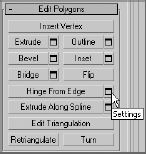
Click the Pick Hinge button and select either of the straight, horizontal edges near the armpit as the hinge for the tool, shown here. The selected polygons' new orientation will be previewed in the target orientation in the viewports.
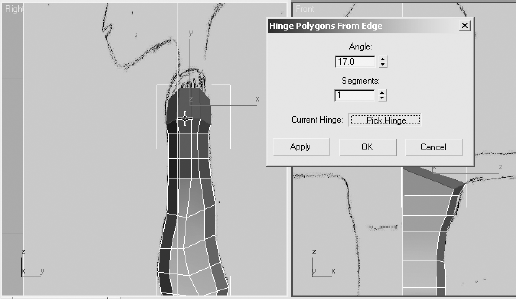
Set the Angle parameter value to 17, and click the Apply button. The previewed orientation will set into the model. Now, the selected polys will be previewed rotating another 17 degrees about the selected edge because you are still in the Hinge Polygons from Edge tool. Click the OK button to accept the second hinge action and exit the tool. Your model should look similar to Figure 6.6.
Switch to the Vertex sub-object level and adjust the vertices to define the clavicle and shoulder area, as shown here.
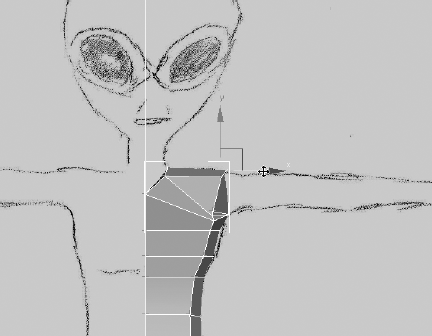
Note
Throughout the modeling process, you may find yourself turning the See-Through mode on and off to hide and unhide the background images and to isolate the model. The images in this chapter switch between these modes as required. Press Alt+X to toggle See-Through on and off easily. Alt+Q will get you into (but not out of) Isolation mode. To exit Isolation mode, you will have to click the floating yellow button.
The Chamfer tool in the Edit Vertices rollout is similar to the Chamfer tool in the Edit Edges rollout. Rather than subdividing an edge into two colinear edges, it creates a new polygon by creating new vertices, projecting into all the polygons that share each selected vertex. For more on this, see Chapter 4. If the arm were extruded now, it would be very boxy and would require the edges to be chamfered. But by first chamfering the vertices, the resulting extrusion is more acceptable.
Zoom into the shoulder and select the four vertices at the corners of its perimeter. Click the Settings button (

In the Chamfer Vertices dialog box that opens, increase the chamfer amount to divide the angle between the perpendicular edges, as shown here. Click the OK button when you are done.
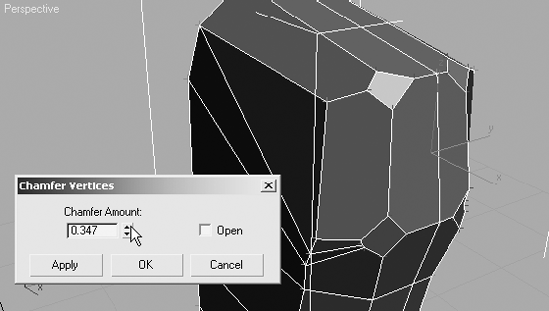
A vertical edge that bisects the polygons will be extruded to make the arm. If this vertical edging remains, it will create undesired internal polygons. However, selecting and deleting the offending edge would also delete the polygons that it contributes to theperimeter, which would leave a hole in the model. The Remove tool deletes the edge andcombines the adjacent polygons into a single polygon, solving our problem.
In Edge sub-object mode, select the edge and click the Remove button in the Edit Edges rollout as shown. The edge will be deleted and the perimeter will remain intact. Yay!

Select the polygon where the arm will be, and extrude it to about half the length of the upper arm.
Move the vertices to straighten the arm, and then select and scale all end vertices down slightly as shown.

Repeat steps 10 and 11 two more times, scaling the vertices up at the elbow and then down at the wrist to resemble the following graphic.

Similar to the extrusion modeling procedures described in Chapter 4's Hand exercise, block out the basic form for the alien's hand to have three long fingers and one thumb. You need not get into the smoothing details of the Chapter 4 Hand exercise using NURMS; however, the basic blocky hand for the alien will suffice. When completed, the hand and fingers should look similar to those shown in Figure 6.7. Save!
Adding the Legs
To create the legs and feet, you'll use methods similar to the ones you have used to build the Alien model so far. Extruding polygons, chamfering vertices and edges, and scaling vertices and polygons are all mainstays of polygonal modeling. In this section, you will also use the QuickSlice tool to add edges to polygons where additional detail is necessary, as you did in the Dresser exercise in Chapter 4. Continue with the previousexercise or open the Alien3.max scene file in the Alien Model folder from the companion CD.
Hide the Alien Front Image object or move it behind the model so that it doesn't obstruct the view in the Perspective viewport.

Arc-rotate and zoom into the polygon that will be extruded to create the leg at the bottom of the model.
Select the edge that bisects the bottom polygons as shown here, and use the Remove tool to get rid of the edge. Do not just delete the edge.

Select the bottom polygon. In the Edit Geometry rollout, click the QuickSlice button, as shown here. The cursor will turn into an arrow.
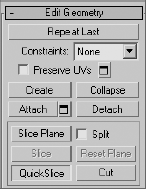
The intent here is to add an additional polygon near the centerline of the model to accommodate the detail around the crotch. Click on the edge in the front of the model that runs from the center to the side, near the symmetry plane that divides the model in half.
Move the cursor. A thin line that projects from the initial point through the tip of the cursor to the edge of the selected polygon will be selected.

Click in a similar location on the opposite edge at the back of the model. A new edge will appear, and the single selected polygon will be divided into two coplanar polygons, as shown below left.
Click the QuickSlice button to turn it off.
Select the larger polygon and extrude it about half the distance to the knee.
Select and then move and scale the vertices at the knee of the leg to match the reference images, as shown here.

Repeat the leg extrusions at the alien's knee, mid-calf, and ankle. Adjust the vertices at each location, shown here.

Arc-rotate so that you can see the inner portion of the leg. These edges are not chamfered like the edges on the outside of the leg. Select one inside-vertical edge at the front of the model and another at the back of the model.
In the Selection rollout, click the Loop button, as shown here. Loop expands the selection to include all edges that meet, end to end, and are aligned with the selected edges. See Chapter 4 for more on Loop.

Note
Instead of expanding the selection, you can use the spinner arrows next to the Loop button, to shift the edge selection to the next aligned edges. The Loop tools at the other sub-objectlevels work in a similar fashion.
All of the inside edges from the ankle to the crotch are selected. Use the Chamfer tool or the Chamfer Settings tool to subdivide the edges as shown here. Make sure to saveyou work if you haven't been doing so all along.
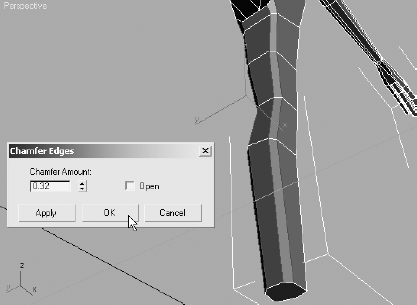
Adding the Feet
Now that the alien has a leg to stand on, you need to give him a foot. You'll continue using the Extrude and Chamfer tools along with the Hinge Polygons from Edge dialog box, as you did with the hand. You can continue the previous exercise for the following steps:
Extrude the polygon at the base of the leg, until it extends to the bottom of the foot.
Select the polygon at the back of the foot and use Hinge Polygons From Edge with an angle of 37.5 (as shown here) to create the polygons that make up the heel portion of the foot. Pick the edge at the top of the heel as the hinge. Click OK to close the dialog box.

Chamfer the edges of the polygons created with the Hinge from Edge tool, and then adjust the vertices as required to fit the form of the reference.
Extrude the polygon, at the front of the ankle, twice to create the foot. The first extrusion is used to make the transition from the ankle to the foot, and the second extends the foot to the beginning of the toes, as shown here.

If the foot is pivoted incorrectly, select all of the vertices from the ankle down and rotate them until the foot points forward and slightly outward, as shown here.

Continue to edit the vertices and edges of the feet to block out their basic forms to match the front and side reference images.
Use the QuickSlice and Extrude tools, along with the transforms, to create the alien's toes and complete the leg, as shown. Save—but I don't need to tell you that!

Modeling the Head
The last major component to add to the model is the alien's head. In addition to the tools that have already been covered, the Cut tool, the Soft Selection method, and the Shaded Face Toggle option are added to your 3ds Max modeling toolset options. You may continue with your work from the previous steps or open the Alien4.max scene file in the Alien Model folder from the companion CD.
Zoom into the top of the model, where the neck will be. Select the vertices at the base of the neck, along the symmetry plane, and move them vertically as shown here.
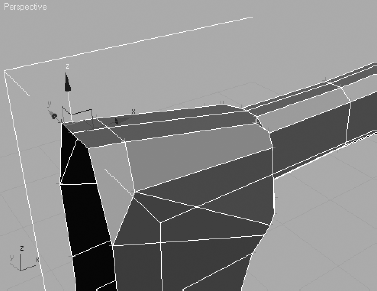
Select the two polygons at the top of the neck and click the Z button, next to the Make Planar button in the Edit Geometry rollout, as shown here. This will rotate all of the selected polygons to make them flush with the Z plane.

Select the edge that divides the top polygons, depicted here as a dark gray line (yours will be red when selected), and remove it with the Remove tool.
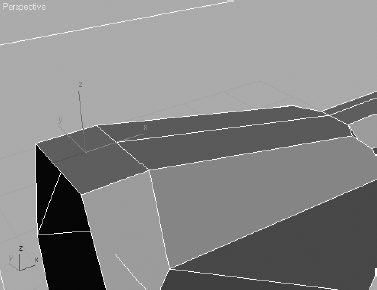
You will need to refine the edges of the neck that you will extrude to create the neck in the next step. The objective here is to reduce the angle of the corner edges of the top polygon by adding additional edges to cut the corners. Instead of chamfering the edges or vertices, click the Cut tool in the Edit Geometry rollout. Create a new edge at the first corner by clicking at each point where you want the vertices of thatnew edge to be (shown here). Right-click to begin a new cut line, and create a new edge at the other corner (shown here as black lines). Click the Cut button when you are done.
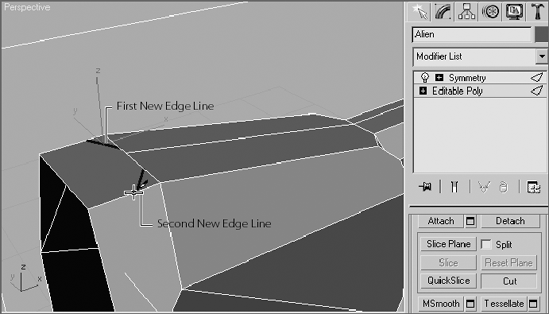
Extrude the neck polygon upward and adjust its vertices to match the front and side reference images, as shown here. With the neck geometry in place, you'll see that the alien's chin will be well below the top of the neck in the side image. This is fine, so don't worry about it—yet.
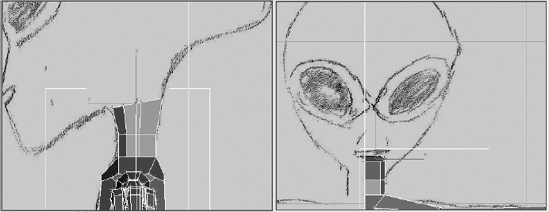
Using the Extrude tool, move the vertices as required to form the front and sides of the head so it will be similar to the model shown in Figure 6.8.
Extrude the polygons at the back of the head about half the remaining distance to the back of the head in the reference image, and then scale the vertices down a bit.

When sub-objects are moved, rotated, or scaled, the effect is applied explicitly and fully only to the selected sub-objects. This can result in a blocky, uniform appearance that isunappealing for an organic model. Soft selection lessens this effect by applying the transforms fully to the selected sub-objects and then, to a lesser degree, to the sub-objects that are in close proximity to the selection. The sub-objects that are closer to selection are more affected by the transform, and those that are farther away are less effective. Whensoft selection is used, 3ds Max color codes the selected sub-objects to provide a visual cue regarding how much of an effect the transforms will have. The colors range from red to orange to yellow to green to blue, with red sub-objects being fully affected and blue being unaffected. For more on soft selection, see Chapter 4. Let's try soft selection as we continuethe alien model here.
In the Soft Selection rollout, check the Use Soft Selection option and click the Shaded Face Toggle button as shown here.

Increase or decrease the falloff value until the non-blue colors extend to polygons at the side of the head.

Move and scale the end polygons to match the reference image as neatly as possible with the current geometry.
Refining the Head
As you can see, the head needs additional segmentation to better match the reference image. We'll use the Connect tool to add that segmentation. The Connect tool adds edges to a model by subdividing pairs of selected edges. Continue from the previous exercise's steps and your current work.
Turn off Use Soft Selection and switch to the Edge sub-object level.
Select any of the nearby horizontal edges on the side of the head that need to be subdivided.
In the Selection rollout, click the Ring button as shown here. Similar to the Loop tool, the Ring tool selects all edges that are nearly parallel to the selected edge and lie along the same plane (for more, see Chapter 4). All the horizontal edges that need to be subdivided are selected, as shown in Figure 6.9.
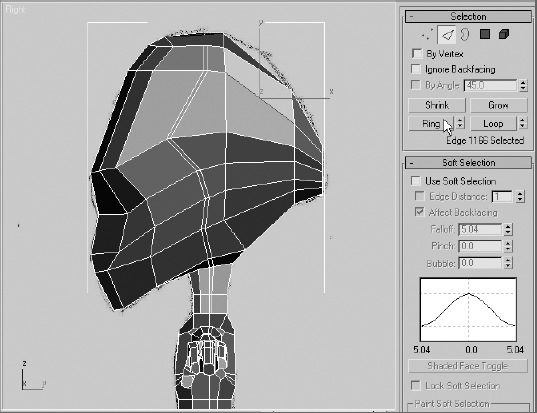
To open the Connect Edges dialog box, click the Settings button next to the Connect button in the Edit Edges rollout. Set the Segments value to 2 as shown, and click the OK button. All of the selected edges are subdivided into three edges each.

Turn Use Soft Selection back on and reduce the Falloff value until only two rings of polygons, outside of the selected edges, show any colors other than blue.
Move the selected edges upward as shown to match the reference image.
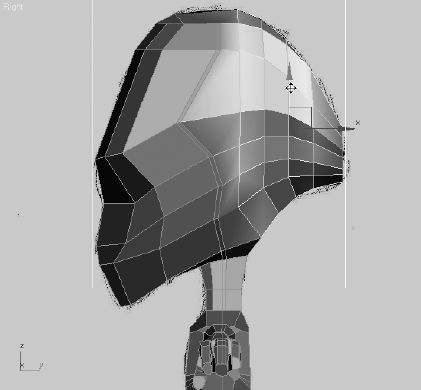
Continue shaping the head using the Connect, Remove, and Soft Selection tools, and by moving the sub-objects to block out the head as desired.
Many polygons were created with the previous steps on what will become the internal area of the head. They must be removed. Access the Polygon sub-object level. In the Front viewport, use a window selection to select all the unwanted polygons and thendelete them, as shown. You saved your work already, right?
Access the Polygon sub-object level. In the Front viewport, use a window selection to select all the unwanted polygons and then delete them.

The basic form of the alien model is complete. The viewer can clearly see a humanoid character with a large head that slopes down in front and tapers in the back. In the next section, we'll cover adding details to the model, including a more-defined musculature, eyes, and a mouth.
With the basic form blocked out, the alien needs to have detail added to define its appearance. You'll start by adding the TurboSmooth modifier to subdivide and smooth the mesh, and then you'll continue the modeling process by working on the legs, arms, torso, and finally the head. TurboSmooth creates a nonrendering framework around the mesh, with its own vertices that can be weighted to control the localized deformation of the mesh.
The TurboSmooth modifier has two iteration options: Iterations and Render Iterations. The Iterations option determines the amount of smoothing the model has in the viewports. If Render Iterations is unchecked, Iterations also determines the amount of smoothing in renderings. When Render Iterations is checked, the amount of smoothing in renderingscan be different, usually higher, than the smoothing shown in the viewports. This allows you to work on a less-dense model for faster feedback on your computer system as you work, and it automatically renders the model at a higher density.
In this section, you'll apply the TurboSmooth modifier to the alien model to smooth its surfaces. You can continue with the previous exercise or open the Alien5.max scene file in the Alien Model folder on the companion CD.
Exit any sub-object level, if necessary, and then select the Symmetry modifier in the Modifier Stack.
Expand the Modifier List and click the TurboSmooth modifier, as shown here. The modifier appears at the top of the Modifier Stack.
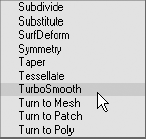
Note
To quickly locate a modifier in the Modifier List, repeatedly press the letter key that corresponds to the first letter in the modifier's name. 3ds Max will select the first modifier that starts with that letter and then cycle through the list, selecting the next modifier that starts with that letter each time the key is pressed. With 3ds Max 2008, you can also hold down the first letter's key and then press the key for the second letter of the modifier's name. 3ds Max will then select it for you.
Set Iterations to 1 and make sure that Isoline Display is unchecked in the main section of the TurboSmooth rollout. Isoline Display causes only the model's original edges to display, rather than all the edges in the newly subdivided mesh, for faster feedback in 3ds Max. When the Iterations parameter is set to a high value, enabling Isoline Display will reduce the display complexity on the model in the viewport.

Note
Use caution when increasing the Iterations value in the TurboSmooth modifier. Dragging the Iterations spinner upward quickly, or directly entering a high value in the Iterations field, can cause 3ds Max to generate an enormous number of polygons that may exceed the memory capacity of your system, resulting in a crash. It is best to increase the Iterations parameter in increments of 1 until the minimum acceptable level of smoothing is obtained. You shouldn't really need to go above 3 iterations at worst.
While you are working in the editable poly level of the Modifier Stack, you will want to see the smoothed result of your character throughout the modeling process. This is easily accomplished by clicking the Show End Result toggle button (
Adding Detail to the Legs
The legs need more detail, especially around the knee, to allow them to deform properly when they are animated. Follow these steps to add leg detail:
Unhide any reference images and zoom into the area around the alien's leg. The knee is one area in particular that needs additional detail to accommodate any deformations caused by animating with Bones or Character Studio.
Select all of the polygons directly above and below the knee, and then use the Quick- Slice tool twice, once above and once below the knee, to add additional segmentation as shown. The angle of the Slice plane should match the angle of the edges above or below the new edges.
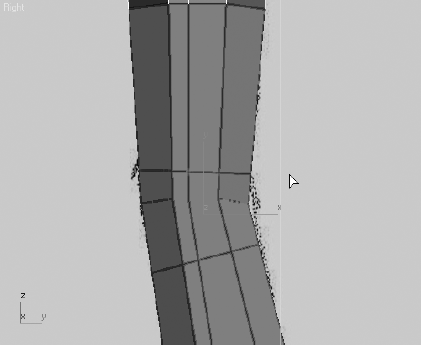
In Vertex sub-object level, select the vertices at the front of the knee. Turn on Use Soft Selection, and then reduce the Falloff value until only the vertices near the front of the knee are fully or partially selected.
Move the vertices forward to create the bulge of the knee cap, as shown.

Turn off Use Soft Selection and then use the Connect tool to further subdivide the edges in the calf area. Move the new edges so they are concentrated around the midcalf area like this.
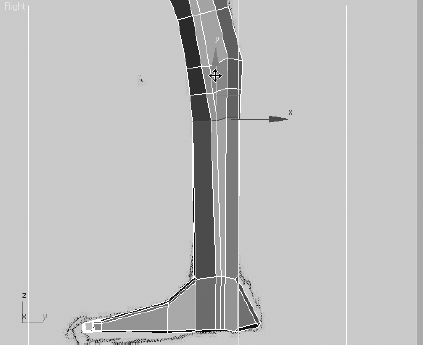
At the Vertex sub-object level, move and scale the vertices to sculpt the calf as shown here.

Adjust the vertices for the thigh area, making sure the vertices near the center do not cross the centerline of the model, as shown here.

Use the tools discussed in this section to finish modeling the legs the way you want them to match the reference images. Using the Cut tool and then using the Bevel Polygons tool is an excellent method for modeling the calcaneus, the bone that protrudes from the side of the ankle, as shown here. To make sure the edits are effective and generating the correct result, toggle the Show End Result button and render the scene frequently to check your progress.

Zoom out and render the legs, and you should have legs that are similar to the graphic shown here. Save!
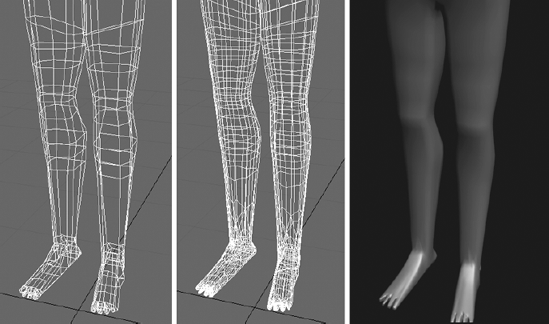
Adding Detail to the Arms
To allow proper deformation, additional detail must be added to the elbow area, in a manner similar to the way you detailed the legs. Additional musculature is also required in the arms and at the shoulders. Be sure to toggle the Show End Result button back and forth to see how the low-polygon modeling affects the final, smooth object.
Select the vertical edges in the arm, from the bicep to the wrist, and use the Connect tool with Segments set at 2 to add additional vertical edges to the arm, as shown here.

Move the new edges near the elbow, leaving one vertical loop of edges at the bicep and the forearm.
With Use Soft Selection turned on, move and scale the elbow until it is slightly larger than the arm, as shown here.

Select the edge in the middle of the bicep. We will use this edge to define the bulge of the bicep. With the character's hands oriented with the palms face down, the bicep should bulge forward and not upward, as shown here.

The character has long slender fingers that tend to look like tubes or tentacles when the diameter of each segment is similar in size. To help define the individual finger bones, you need to increase the size of the knuckles. Select all of the edges located at the alien's knuckles, including the thumb, and chamfer them twice. The second chamfer should concentrate two sets of edges closer to the centerline of the knuckles shown here.
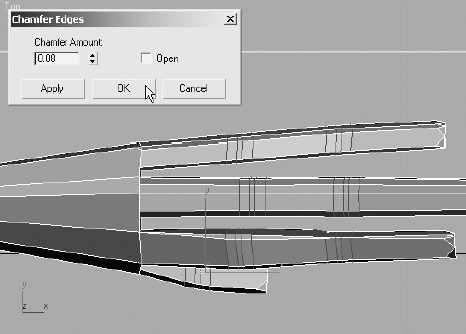
Select the inner pair of edges at each knuckle and scale the edges to increase their diameter to puff out the knuckles as shown.
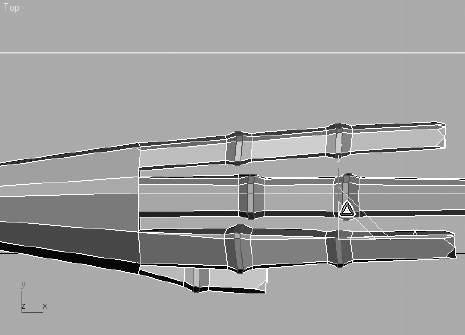
If the knuckles appear to change the fingers' diameters too abruptly, turn on Use Soft Selection and scale them again along the X-axis only.
The hand tapers too smoothly from the wrist to the fingers, so there is no clear line of delineation between the forearm and the fingers. Use the QuickSlice tool to add an additional edge vertically across the hand just above the wrist, and then move and scale it to better define the hand, as shown here.
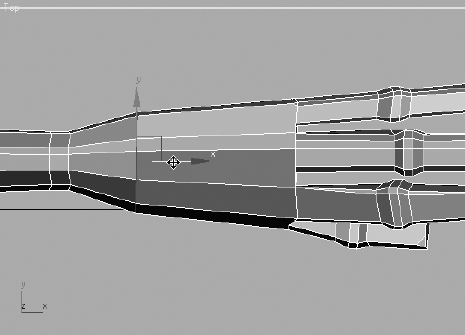
The thumb is tucked under the hand in an unnatural position. Select and move the vertices of the thumb and the inside heel of the palm forward and out from underneath the index finger as shown.
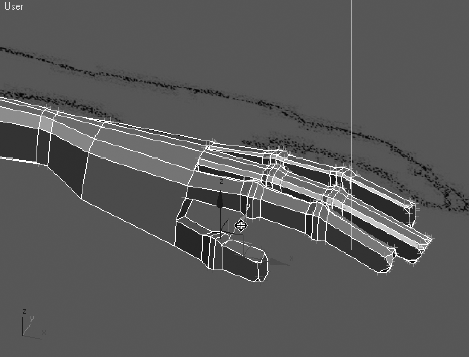
Make any additional changes to the hand to shape it as you wish. For instance, if the finger tips are too boxy in a smooth rendered image, move the vertices near the end of the fingers back a bit, or select and bevel the end polygons of the fingers.
Note
Make sure you save your work as you progress. Saving at every milestone as you work from one body part to another is a good idea.
Refining the Shoulder
We need more detail in the shoulder. As you can see, the shoulder is currently flat from the end of the arm to the neck. In this section you will add the detail required to place a bulge at the top of the shoulder that tapers into the clavicle. Let's start where you left off at the end of the previous exercise.
Select and chamfer the loop of edges that runs over the shoulder and under the armpit. Set Chamfer Amount to 0.25, as shown here. The selected edges around the armpit are shown in gray.
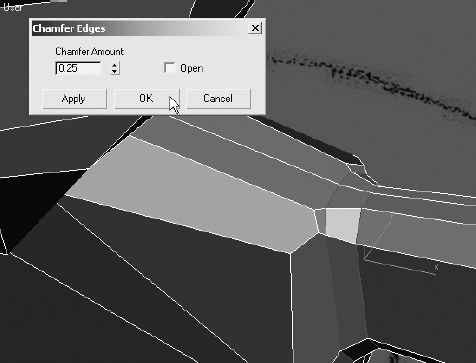
Select the three edges that run along the clavicle (the collarbone), and use the Connect tool to add two more sets of perpendicular edges.
When editable poly sub-objects are moved in a viewport, they adhere to the same transform coordinate system restrictions as any other object in a scene. Similar to using the local transform coordinate system, the Constraints option in the Edit Geometry rollout allows you to limit the movement of the sub-objects to be parallel to the associated edges or polygons. This diminishes any unnecessary deformations caused by moving a sub-object away from a surface of the model. With the four new edges selected, go to the Edit Geometry rollout, and choose the Edge radial button. This constrains the four edges to avoid unwanted movement as you place them.

Move the edges closer to the shoulder, as shown here. Note that they do not leave the plane in which they lie due to the constraint in step 3.

Change the Constraints option back to None to turn off the constraint.
Select the vertex at the top of the shoulder. Using Soft Selection, move it upward to create the shoulder bulge, shown here.
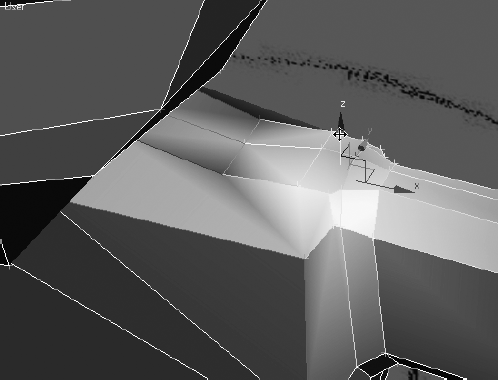
Zoom out and render the modeled arm; it should look similar to Figure 6.10.
The shape of the alien's torso is fairly plain, and decidedly not anatomically correct, so the detail added will be subtle. You will need to add some bulges for the wider hips and a belly button.
Zoom into the alien's hips, and select the three bands of horizontal edges that circle the alien at the waistline. As always, the selected edges are shown darker here.
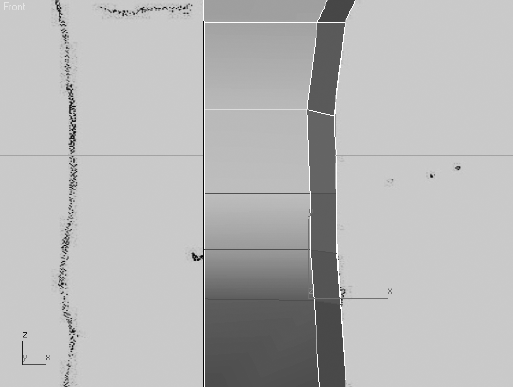
Chamfer the new edges. Using Edge Constraints, move the edges to concentrate them around the hip area as shown.
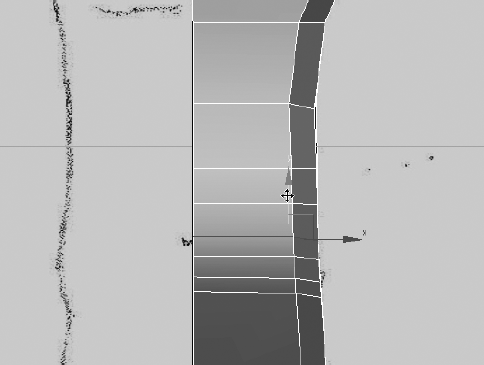
Turn the Constraints off and turn Use Soft Selection on. Move the hip vertices into place to create a wider hip as shown.
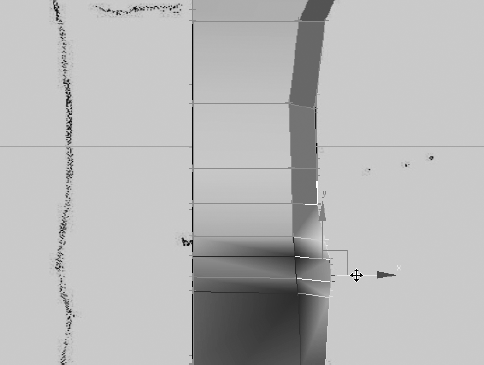
Use the Cut tool to create a perimeter around where the belly button will be and remove any internal edges that may occur.
Select the edges that encircle the intended belly button, omitting the edges along the center line of the model, and chamfer them with a Chamfer Amount of 0.01 as shown. The chamfer creates extra polygons to allow you to indent the belly button without affecting the polygons and edges further away from the belly button.
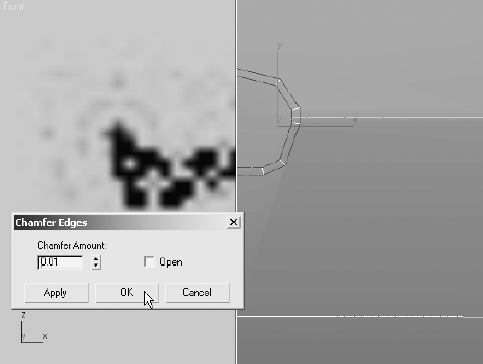
Select the polygon at the center of the belly button and move it into the alien's abdomen to create an "innie," as shown here.

Adding Detail to the Head
Besides the overall shape of the head, the two main features that should be considered are the alien's eyes and mouth. Without lips, a tongue, or teeth to consider, the mouth is the simpler of the two features to model; the mouth simply consists of an appropriately shaped hole in the head. Who doesn't need one of those? Rather than deleting faces though, the mouth will need to be extruded into the head to prevent the appearance of a hollow skull.
The areas surrounding the eyes are going to be modeled using the Cut tool to define the shape of the eyes and then using Chamfer and Extrude to create the raised perimeter. The eyes themselves are spheres that are altered using the Hemisphere parameter. The following steps are a continuation of your work so far in this chapter.
Creating the Mouth
The mouth is going to be a simple extruded polygon, with the extrusion projecting into the alien's head. You'll begin by creating the perimeter of the mouth using the Cut tool.
Zoom into the mouth area to get a good working view.
Use the Cut tool to draw new edges around the perimeter of where you would like the mouth. You can roughly follow the mouth position in the front reference image as shown.

Use the Bevel Polygons dialog box to extrude and scale the polygon into the alien's head as shown. A negative value for the Height parameter causes the bevel to recess the polygon, rather than extrude it out from the head.
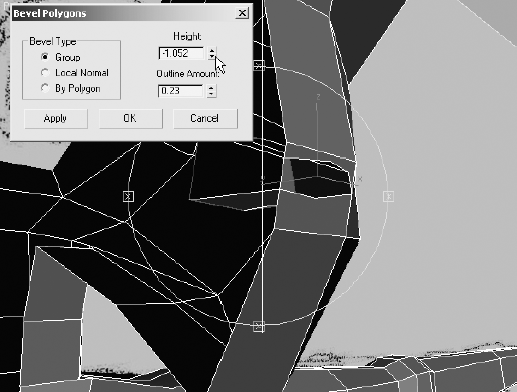
Select the edge at the center line of the mouth and delete it with the Delete key to open that side of the mouth and eliminate any internal faces, as shown here.

Start modeling the eye area by moving vertices around the eye in the reference so the vertices will run around the edges of the raised eye ridge.
To subdivide an edge at a particular location to create a better eye, switch to the Edge sub-object level. Click the Insert Vertex button in the Edit Edges rollout. Click on any edge to place a new vertex at that point, as we do here.

Continue to manipulate the vertices and edges until the eye area is a single, flat polygon. Then, select that single eye polygon and use the Inset Polygons dialog box to create a ring of faces to surround the eye as shown.
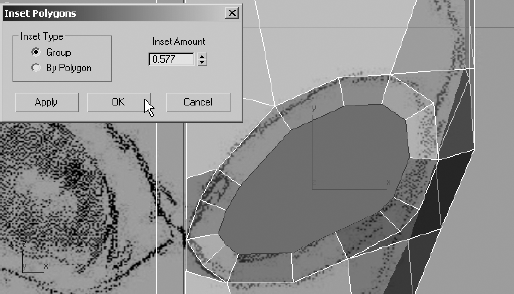
Select and delete the central eye polygon and then select all of the polygons that surround the new hole.
Bevel the selected polygons to create the eye ridge as shown.

Creating the Eyes
Rather than creating the eyes as components of the alien mesh itself, you will make them as separate objects that will be linked to the model. This method allows for greater flexibility when applying materials to, or animating, the eyes.
Exit any sub-object level. Create a sphere with a radius of approximately 3 in the Front viewport where the alien's eye is.
Decrease the Hemisphere parameter value until the visible boundary of the sphere is slightly larger than the eyehole, as shown.

Convert the eye to an editable poly. Rotate and move it to position it correctly in the eye socket.
Make any necessary edits to the vertices or edges to hide any portions of the eyeball sphere that protrude through the surface of the alien's head.
Exit any sub-object level and rename the object Eye Left.
Click the Mirror tool (


Rename the new object Eye Right and make any changes required to make the eye fit in the socket.
Select both eye objects and link them to the Alien object with the Select and Link tool from the main toolbar to cause them to follow the alien's head movement.
The major portion of the modeling is complete. The only remaining tasks are to weld the seams, clean up any areas with unwanted sharp corners, and add a few asymmetrical features so that the model does not look quite so computer generated. You can continue with the previous exercise or open the Alien7.max scene file in the Alien Model folder from the companion CD.
Hide the reference images if necessary to have a better view of what you'll be working on. Save your scene before moving to the next step.

Note
When you've been using the Symmetry or TurboSmooth modifiers (as you have with the alien model), you should always save a copy of the model or entire scene before you convert any model to an editable poly. Do this first, just in case you need to edit it at the Symmetry or TurboSmooth level. You will lose access to those modifiers once you make the conversion.
Select the alien and convert it to an editable poly. This will set the actions of the modifiers into the mesh, and you will not be able to edit those modifiers. Saving the file as you did in the previous step gives you the chance to go back and make changes to the initial model if needed.
Select all of the vertices that share the center line of the model or border on an opening at the center generated now that you have converted to an editable poly. Make sure you don't select any of the vertices from the eye ridges that are close to the center line. You will notice gaps running down the middle seam of the alien in the following graphic. We plan to close these gaps to create a smooth mesh for the alien in the next steps.
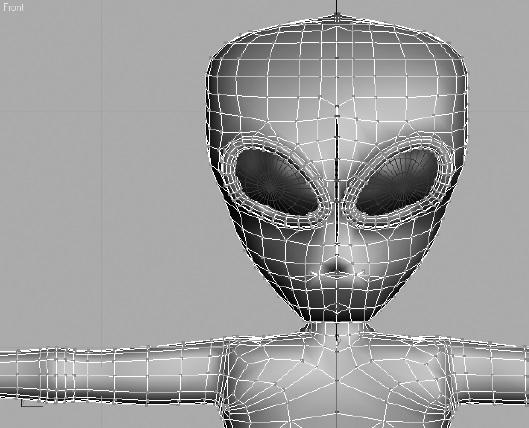
Click the Settings button, next to the Weld button in the Edit Vertices rollout, to open the Weld Vertices dialog box.
The Weld Threshold parameter is the maximum distance that selected vertices can be apart before they are welded. Slowly increase the value for Weld Threshold until the visible gaps are closed as shown here.
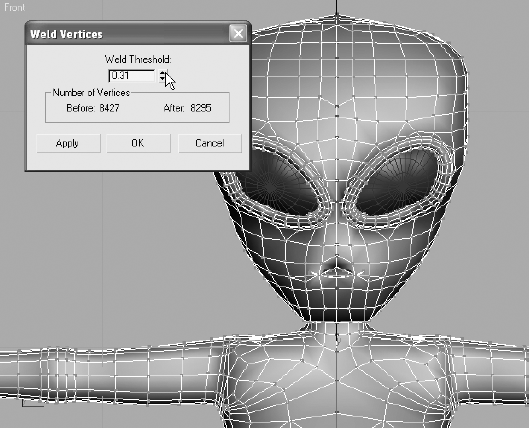
Examine the model closely, especially around the mouth and eyes. Make any corrections you like. In the next steps, we will use Paint Deformations to smooth and finesse the model.
Note
3ds Max uses a paintbrush analogy to reduce the sharpness, or tension, between adjacent polygons. Adjust the size of the virtual brush and click and drag over the areas to be smoothed.
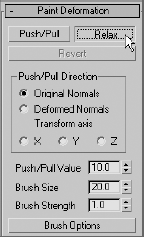
In the Paint Deformation rollout, click the Relax button.
A Brush icon will appear in the viewports as a circle with a line projecting from its center, as shown here. The circle always remains parallel to the surface of the model. Reduce the Brush Size parameter to about 1.0.
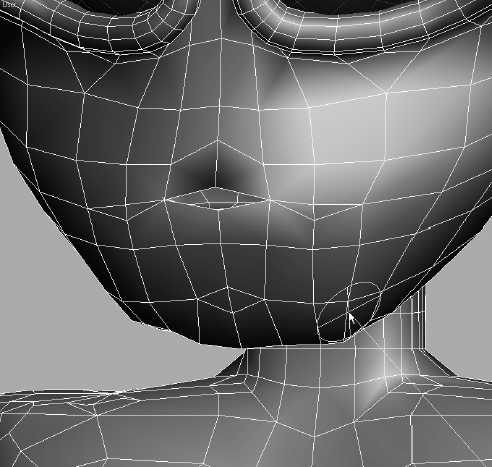
Click and drag the brush over the areas of the mesh you would like to smooth. This reduces the angle between the adjacent polygons, effectively smoothing the area.
Humans, animals, and many other living real-world creatures are basically, but not perfectly, symmetrical. Asymmetrical imperfections are natural and should be reflected in your character models. The vertices around the eyes, the brow, and the mouth are areas to consider altering to make them asymmetrical. The changes should be subtle and should not call attention to the varied area, unless that feature is significant to the character's makeup.
This chapter explored and explained several tools used to create organic models. From a simple box, a torso was formed to match the general shapes shown in the reference images. The Symmetry modifier required you to model only half of the character while it generated the reciprocal half. The legs, arms, and a head followed, all remaining in a simple boxy configuration. The TurboSmooth modifier was added to the top of the Modifier Stack to subdivide and smooth the polygons. Additional detail was added and then the model was collapsed and fine-tuned.
Although we used an alien character here, this toolset can be utilized for any type of organic model.

